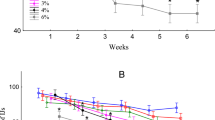Abstract
Successful control of insect pests through theapplication of entomopathogenic nematode dauerjuveniles of H. bacteriophora and H.indica can only be achieved when the nematodematerial reaches the end user in good condition.Storage and formulation techniques must provideoptimum conditions to guarantee a maximum survival andinfectivity of the nematodes. Nematode survival wastested at temperatures ranging between 5–25 °C.A maximum survival of H. indica was achieved at15 °C and the highest mortality at 5 °C.H. bacteriophora survived best at 7.5 °Cand least at 25 °C. An increase of the saltconcentration had positive effects on dauer juvenilesurvival in aqueous suspensions. Low pH between 6 and4 reduced the bacterial growth and prolonged survivalof stored dauer juveniles. Of the organic acidsascorbic, benzoic, citric and sorbic acid, onlyascorbic acid had a positive effect on H. indicasurvival. Extracts of the dried spice plants cinnamon,cloves, rosemary and oregano were tested. Enhancementof H. indica survival was recorded for cinnamonand cloves. Survival and infectivity of nematodesstored in attapulgite and bentonite clays and spongewere recorded over several weeks at different storagetemperatures. Infectivity was not influenced by thedifferent formulation materials. When stored insponge at 25 °C nematodes survived less than 1week and the formulation in clay could only prolongthis period for another week. At 5 °C thesurvival of H. bacteriophora in sponge wassuperior to that in clay, whereas H. indicasurvived less well in sponge than in clay at15 °C. Storage in aerated water at 5 °Cfor H. bacteriophora and at 15 °C for H. indica resulted in the lowest mortality. Forstorage at controlled conditions (temperature, pH andosmolarity), aerated water is superior to all othermethods tested and the addition of preservatives willincrease survival.
Similar content being viewed by others
References
Backhaus, G., 1991. Insektenparasitäre Nematoden gegen den Gefurchten Dickmaulrüßler. Gartenbau und Gartenbauwissenschaft 2: 80–85.
Beuchat, L.R., 1994. Antimicrobial properties of spices and their essential oils. In: V.M. Dillon and R.G. Board (eds), Natural Antimicrobial Systems and Food Preservation. CAB International. pp. 167–179.
Dillon, V.M. and P.E. Cook, 1994. Biocontrol of undesirable microorganisms in food. In: V.M. Dillon and R.G. Board (eds), Natural Antimicrobial Systems and Food Preservation. CAB International. pp. 255–296.
Ehlers, R.-U., S. Lunau, K. Krasomil-Osterfeld and K.H. Osterfeld, 1998. Liquid culture of the entomopathogenic nematode-bacterium complex Heterorhabditis megidis/Photorhabdus luminescens. BioControl 43: 77–86.
Ehlers, R.-U., I. Niemann, S. Hollmer, O. Strauch, D. Jende, M. Shanmugasundaram, U.K. Mehta, S.K. Easwaramoorthy and A. Burnell, 2000. Mass production potential of the bacto-helminthic biocontrol complex Heterorhabditis indica-Photorhabdus luminescens. Biocontr.Sci.Technol. 10, in press.
Ehlers, R.-U. and A. Peters, 1998. Bekämpfung von Engerlingen auf Sportrasen.
Fan, X. and W.M. Hominick, 1991. Effects of low storage temperature on survival and infectivity of two Steinernema species (Nematoda: Steinernematidae). Revue Nématol. 14: 407–412.
Finney, D.J., 1971. Probit Analysis. Cambridge University Press, Cambridge, UK. 331 pp.
Georgis, R., 1990. Formulation and application technology. In: R. Gaugler and H.K. Kaya (eds), Nematodes in Biological Control. CRC Press, Boca Raton.
Georgis, R. and H K. Kaya, 1998. Formulation of entomopathogenic nematodes. In: H.D. Burges (ed), Formulation of Microbial Biopesticides: Beneficial Microorganisms, Nematodes and Seed Treatments. Kluwer Academic Publishers, Dordrecht. pp. 289–308.
Glazer, I., 1996. Survival mechanisms of entomopathogenic nematodes. Biocontr.Sci.Technol. 6: 373–378.
Griffin, C.T., M. Finnegan and M.J. Downes, 1994. Environmental tolerance and the dispersal of Heterorhabditis: survival and infectivity of European Heterorhabditis following prolonged immersion in seawater. Fundam.appl.Nematol. 17: 415–421.
Hanula, J.L., 1993. Vertical distribution of black vine weevil (Coleoptera: Curculionidae) immatures and infection by entomogenous nematodes in soil columns and field soil. J.Econ.Entomol. 86: 340–347.
Jessen, P., O. Strauch, U. Wyss, R. Luttmann and R.-U. Ehlers, 2000. Carbon dioxide triggers dauer juvenile recovery of entomopathogenic nematodes (Heterorhabditis spp.). Nematology 2, in press.
Johnigk, S.A. and R.-U. Ehlers, 1999a. Juvenile development and life cycle of Heterorhabditis bacteriophora and H.indica (Nematoda: Heterorhabditidae). Nematology 1: 251–260.
Johnigk, S.A. and R.-U. Ehlers, 1999b. Endotokia matricida in hermaphrodites of Heterorhabditis spp. and the effect of the food supply. Nematology 1: 717–726.
Jung, K., 1996. Storage of entomopathogenic nematodes of the genus Heterorhabditis at two temperatures. Effect on infectivity, energy reserve and number of bacteria. IOBC/WPRS Bulletin 19(9): 103–106.
Kaya, H.K. and P. Stock, 1997. Techniques in insect nematology. In: L.A. Lacey (ed), Manual of Techniques in Insect Pathology. Academic Press, San Diego. pp. 282–324.
Kendall, M.G., 1938. A new measure of rank correlation. Biometrika 30: 81–93.
Lunau, S., S. Stoessel, A.J. Schmidt-Peisker and R.-U. Ehlers, 1993. Establishment of monoxenic inocula for scaling up in vitro cultures of the entomopathogenic nematodes Steinernema spp. and Heterorhabditis spp. Nematologica 39: 385–399.
Poinar, G.O., Jr., G.K. Karunakar and H. David, 1992. Heterorhabditis indicus n. sp. (Rhabditida: Nematoda) from India: separation of Heterorhabditis spp. by infective juveniles. Fundam.appl.Nematol. 15: 467–472.
Strauch, O. and R.-U. Ehlers, 1998. Food signal production of Photorhabdus luminescens inducing the recovery of entomopathogenic nematodes Heterorhabditis spp. in liquid culture. Appl.Microbiol.Biotechnol. 50: 369–374.
Strauch, O. and R.-U. Ehlers, 2000. Influence of the aeration rate on yields of the biocontrol nematodes Heterorhabditis megidis in monoxenic liquid cultures. Appl.Microbiol.Biotechnol., in press.
Strauch, O., S. Stoessel and R.-U. Ehlers, 1994. Culture conditions define automictic or amphimictic reproduction in entomopathogenic rhabditid nematodes of the genus Heterorhabditis. Fundam.appl.Nematol. 17: 575–582.
Womersley, C.Z., 1990. Dehydration survival and anhydrobiotic potential. In: H.K. Kaya and R. Gaugler (eds), Entomopathogenic Nematodes in Biological Control. CRC Press, Boca Raton. pp. 117–138.
Author information
Authors and Affiliations
Corresponding author
Rights and permissions
About this article
Cite this article
Strauch, O., Niemann, I., Neumann, A. et al. Storage and formulation of the entomopathogenicnematodes Heterorhabditis indica and H. bacteriophora. BioControl 45, 483–500 (2000). https://doi.org/10.1023/A:1026528727365
Issue Date:
DOI: https://doi.org/10.1023/A:1026528727365




